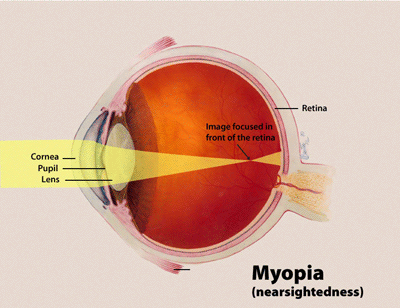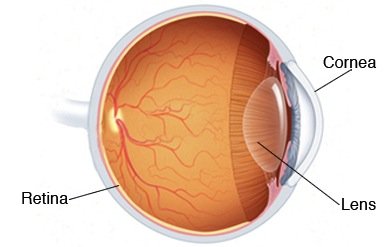Myopia

Near-sightedness / Short-sightedness
Myopia is a common vision condition in which you can see objects near to you clearly, but objects farther away are blurry. It occurs when the shape of your eye causes light rays to bend (refract) incorrectly, focusing images in front of your retina instead of on your retina.
Myopia may develop gradually or rapidly, often worsening during childhood and adolescence. Short sightedness tends to run in families.

Symptoms
Symptoms may include:
- Blurry vision when looking at distant objects
- The need to squint or partially close the eyelids to see clearly
- Headaches caused by eyestrain
Myopia is often first detected during childhood and is commonly diagnosed between primary school and teenage years.
A child with near-sightedness may:
- Persistently squint

- Need to sit closer to the television, movie screen or the front of the classroom
- Seem to be unaware of distant objects
- Blink excessively
- Rub his or her eyes frequently
Causes
Anatomy of the eye
Your eye has two parts that focus images:
- The cornea is the clear, dome-shaped front surface of your eye.
- The lens is a clear structure behind the pupil of your eye.
In a normally shaped eye, each of these focusing elements has a perfectly smooth curvature. A cornea and lens with such curvature bend (refract) all incoming light to make a sharply focused image directly on the retina, at the back of your eye.

A refractive error
If your cornea or lens isn't evenly and smoothly curved, light rays aren't refracted properly, and you have a refractive error.
Myopia usually occurs when your eyeball is longer than normal or your cornea is curved too steeply. Instead of being focused precisely on your retina, light is focused in front of your retina, resulting in a blurry appearance for distant objects.
Risk factors
Certain risk factors may increase the likelihood of developing myopia, such as:
- Genetics. Short sightedness tends to run in families. If one of your parents is myopic, your risk of developing the condition is increased.
- Reading and close-up work. People who do a lot of reading, writing or computer work may be at increased risk of myopia. The amount of time you spend playing electronic games or watching television also can play a role. Even holding reading material too close has been associated with increased myopia.
- Environmental conditions. Some studies support the idea that a lack of time spent outdoors may increase the chances of developing myopia.
Complications
Near-sightedness is associated with a variety of complications from mild to severe, such as:
- Reduced quality of life. Uncorrected short-sightedness can affect your quality of life. You might not be able to perform a task as well as you wish. Your limited vision may detract from your enjoyment of day-to-day activities.
- Eyestrain. Uncorrected near sightedness may cause you to squint or strain your eyes to maintain focus. This can lead to eyestrain and headaches.
- Other eye problems. Severe myopia puts you at a slightly increased risk of retinal detachment, glaucoma, cataracts and myopic maculopathy — damage to your retina. The tissues in long eyeballs are stretched and thinned, causing tears, inflammation, new blood vessels that are weak and bleed easily, and scarring.
When to see a doctor
If your difficulty seeing things that are far away clearly is pronounced enough that you can't perform a task as well as you wish, or if the quality of your vision detracts from your enjoyment of activities you should organise an eye examination.
If you have any concerns about your own or your child’s eyes or suspect they may be short sighted – Please don’t hesitate to contact the clinic on 021 4341030 or bgolchin@corkeyeclinic.ie







